The NVIDIA GeForce GTX 750 Ti and GTX 750 Review: Maxwell Makes Its Move
by Ryan Smith & Ganesh T S on February 18, 2014 9:00 AM ESTPower, Temperature, & Noise
As always, last but not least is our look at power, temperature, and noise. Next to price and performance of course, these are some of the most important aspects of a GPU, due in large part to the impact of noise. All things considered, a loud card is undesirable unless there’s a sufficiently good reason – or sufficiently good performance – to ignore the noise.
| GeForce GTX 750 Series Voltages | ||||
| Ref GTX 750 Ti Boost Voltage | Zotac GTX 750 Ti Boost Voltage | Zotac GTX 750 Boost Voltage | ||
| 1.168v | 1.137v | 1.187v | ||
For those of you keeping track of voltages, you’ll find that the voltages for GM107 as used on the GTX 750 series is not significantly different from the voltages used on GK107. Since we’re looking at a chip that’s built on the same 28nm process as GK107, the voltages needed to drive it to hit the desired frequencies have not changed.
| GeForce GTX 750 Series Average Clockspeeds | |||||
| Ref GTX 750 Ti | Zotac GTX 750 Ti | Zotac GTX 750 | |||
| Max Boost Clock |
1150MHz
|
1175MHz
|
1162MHz
|
||
| Metro: LL |
1150MHz
|
1172MHz
|
1162MHz
|
||
| CoH2 |
1148MHz
|
1172MHz
|
1162MHz
|
||
| Bioshock |
1150MHz
|
1175MHz
|
1162MHz
|
||
| Battlefield 4 |
1150MHz
|
1175MHz
|
1162MHz
|
||
| Crysis 3 |
1149MHz
|
1174MHz
|
1162MHz
|
||
| Crysis: Warhead |
1150MHz
|
1175MHz
|
1162MHz
|
||
| TW: Rome 2 |
1150MHz
|
1175MHz
|
1162MHz
|
||
| Hitman |
1150MHz
|
1175MHz
|
1162MHz
|
||
| GRID 2 |
1150MHz
|
1175MHz
|
1162MHz
|
||
| Furmark |
1006MHz
|
1032MHz
|
1084MHz
|
||
Looking at average clockspeeds, we can see that our cards are essentially free to run at their maximum boost bins, well above their base clockspeed or even their official boost clockspeed. Because these cards operate at such a low TDP cooling is rendered a non-factor in our testbed setup, with all of these cards easily staying in the 60C or lower range, well below the 80C thermal throttle point that GPU Boost 2.0 uses.
As such they are limited only by TDP, which as we can see does make itself felt, but is not a meaningful limitation. Both GTX 750 Ti cards become TDP limited at times while gaming, but only for a refresh period or two, pulling the averages down just slightly. The Zotac GTX 750 on the other hand has no such problem (the power savings of losing an SMX), so it stays at 1162MHz throughout the entire run.

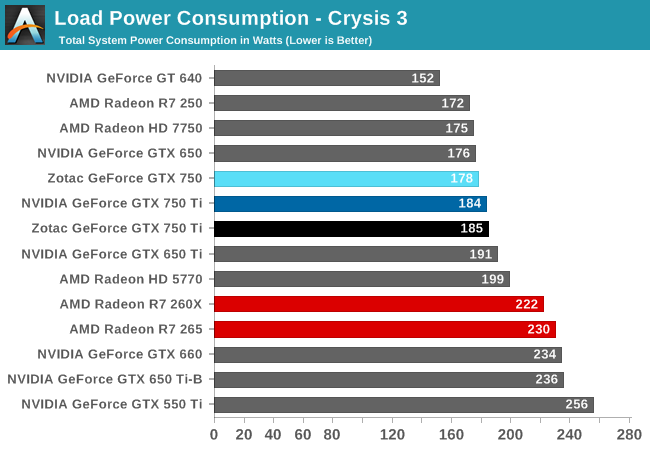
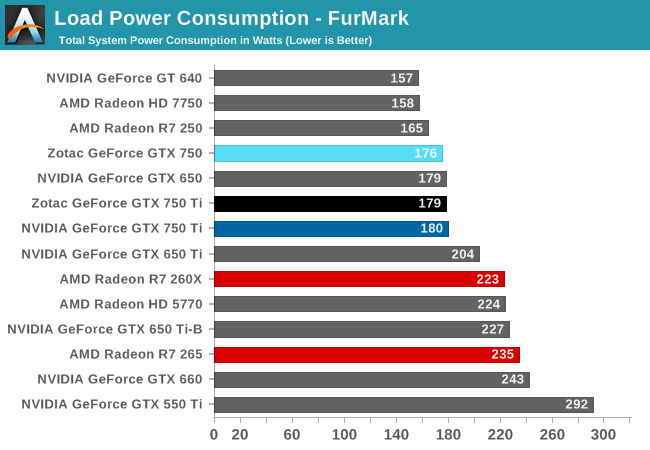


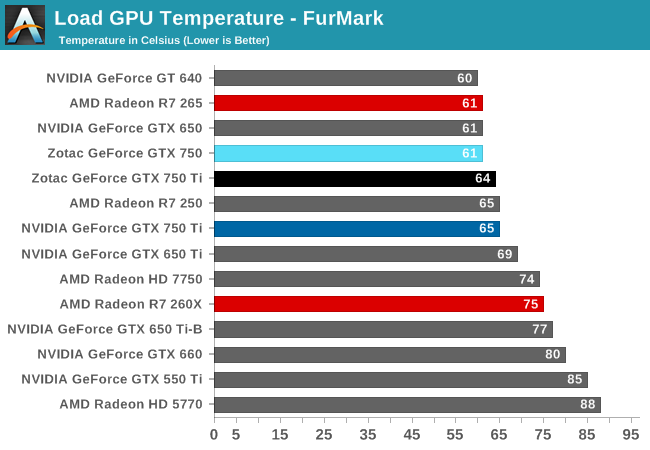
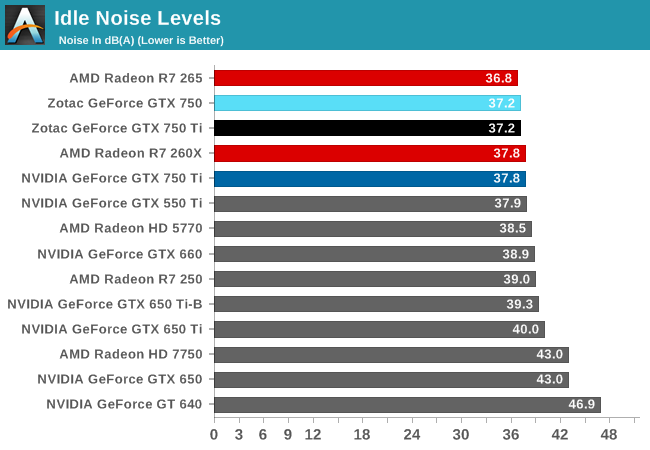
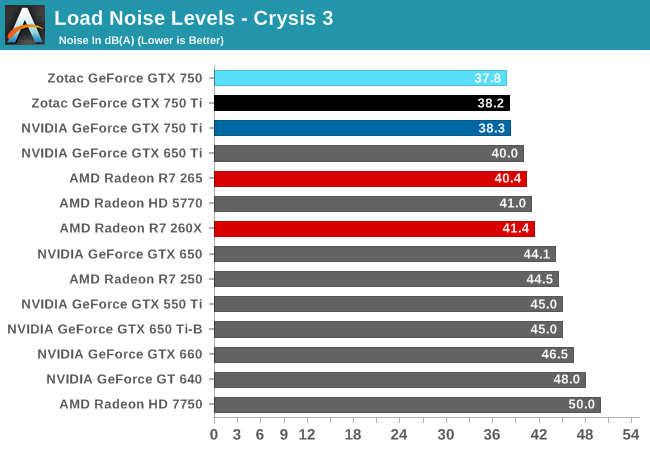
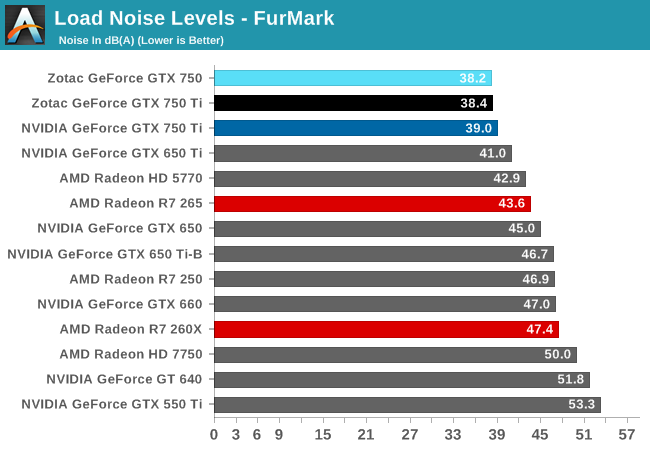










177 Comments
View All Comments
rish95 - Wednesday, February 19, 2014 - link
Yes. You can run PCIe 3.0 cards on 2.0 slots.rish95 - Wednesday, February 19, 2014 - link
This card is quite literally jesus for me. I've been waiting for something like this for a few years now.Currently I'm running an Athlon II X4 with a GT 240 on an OEM 250W PSU. I know it sounds like that may be a bit much for the PSU, but it's been working fine for years.
There haven't been any cards without external power connectors released since the GT 240 that have been significantly faster. I know I could have jumped to an HD 7750, but it's still not that much of an improvement. Now I can get a massive 3-4X performance boost without upgrading my PSU.
I hope this was worth the wait. I've had a copy of Crysis 3 for some time that I couldn't use because the 240 doesn't support DX11.
cbrownx88 - Wednesday, February 19, 2014 - link
Good for you man! This does sound like quite the fit! Hope your power supply keeps hangin in there!Antronman - Wednesday, February 19, 2014 - link
These cards will barely be able to run Crysis 3.rish95 - Wednesday, February 19, 2014 - link
Did you even read the review? It seems to manage 36 FPS at high settings at 1080p.I don't need Very High and I don't need 60 FPS. I just need it to look pretty good and run at a playable frame rate at native res.
This does seem to fit the bill.
Qwertilot - Thursday, February 20, 2014 - link
The only worry in some ways is that the 20nm version of this is inevitably going to be non trivially better at the same sort of power draw. I guess it isn't at all certain if they'll do a roughly equivalent one now though. Obviously not terribly soon. Might end up skipping to 16nm or something.HighTech4US - Wednesday, February 19, 2014 - link
Quote: NVIDIA is making a major effort to target GTX 550 Ti and GTS 450 owners as those cards turn 3-4 years old, with the GTX 750 series able to easily double their performance while reducing power consumption.And they have gotten me to upgrade my HTPC GPU that was on an EVGA GTS 450 to a brand new EVGA 02G-P4-3753-KR GeForce GTX 750 Ti Superclocked 2GB which I just purchased on Newegg for $160.38.
http://www.newegg.com/Product/Product.aspx?Item=N8...
This card is factory overclocked at Core Clock: 1176MHz Boost Clock: 1255MHz has a DisplayPort connector and a better copper heat assisted heat sink and fan shroud that exits some of the heat out the back bracket.
I will be selling my old EVGA GTS 450 on eBay and should clear $60 so I will have a very nice card for the next 3-4 years for an upgrade price of around $100. Not bad at all.
pierrot - Wednesday, February 19, 2014 - link
Awesome this ITX friendly size is the standard, just need power nowninjaquick - Thursday, February 20, 2014 - link
As neat as this is, it only proves that Maxwell scales within its TDP. It is consistent where it is at.devdollers@gmail.com - Friday, February 21, 2014 - link
wow..............